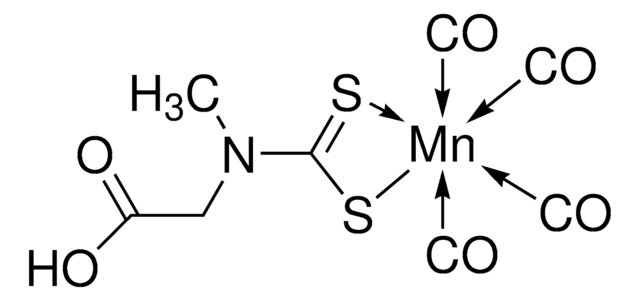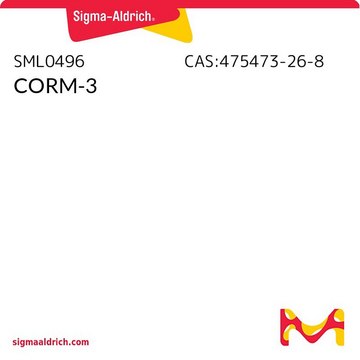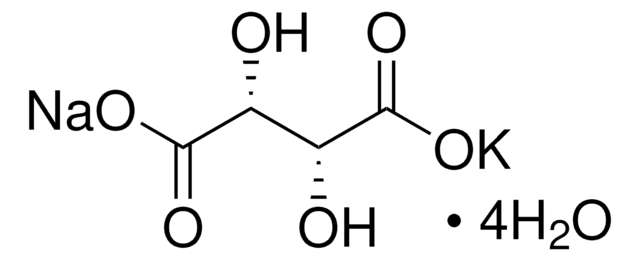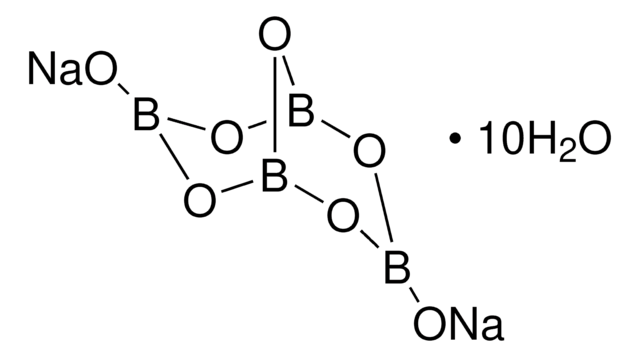SML0315
CORM-A1
≥95% (NMR)
Sinónimos:
Sodium boranocarbonate
Iniciar sesiónpara Ver la Fijación de precios por contrato y de la organización
About This Item
Fórmula empírica (notación de Hill):
CH3BNa2O2
Número de CAS:
Peso molecular:
103.82
MDL number:
UNSPSC Code:
12352200
PubChem Substance ID:
NACRES:
NA.77
Productos recomendados
Quality Level
assay
≥95% (NMR)
form
powder
storage condition
desiccated
color
white to beige
solubility
H2O: >15 mg/mL
storage temp.
room temp
SMILES string
[Na+].[Na+].[BH3-]C([O-])=O
InChI
1S/CH4BO2.2Na/c2-1(3)4;;/h2H3,(H,3,4);;/q-1;2*+1/p-1
InChI key
SOFPSQNQOQPAAJ-UHFFFAOYSA-M
Application
CORM-A1 has been used:
- to deliver carbon monoxide (CO) and to test its cytoprotection in yeast and primary astrocytes culture during oxidative stress
- as CO donor in murine macrophages J774A.1 cells to test its effect on cellular β-endorphins elevation
- to test its effect on mitophagy activation in retinal ganglion cells
Biochem/physiol Actions
CORM-A1 is a water-soluble carbon monoxide (CO) releasing molecule that can be used to study the effects of CO on cellular systems. Carbon monoxide (CO), produced during the degradation of heme by the enzyme heme oxygenase is an important gaseous signaling mediator in mammalian cells CORM-A1 has anti-oxidant and anti-inflammatory activity.
It mediates the release of CO in a pH and temperature-dependent manner, thus favoring mild vasorelaxation and hypotension. During oxidative stress, CORM-A1 is reported to provide cytoprotection in astrocyte primary cultures. This boron-containing CORM promotes autophagy.
Storage Class
11 - Combustible Solids
wgk_germany
WGK 3
flash_point_f
Not applicable
flash_point_c
Not applicable
Elija entre una de las versiones más recientes:
Certificados de análisis (COA)
Lot/Batch Number
¿No ve la versión correcta?
Si necesita una versión concreta, puede buscar un certificado específico por el número de lote.
¿Ya tiene este producto?
Encuentre la documentación para los productos que ha comprado recientemente en la Biblioteca de documentos.
Los clientes también vieron
Kapil K Upadhyay et al.
Redox biology, 28, 101314-101314 (2019-09-13)
Nuclear factor-erythroid 2 related factor 2 (Nrf2)-mediated signaling plays a central role in maintaining cellular redox homeostasis of hepatic cells. Carbon monoxide releasing molecule-A1 (CORM-A1) has been reported to stimulate up-regulation and nuclear translocation of Nrf2 in hepatocytes. However, the
Helena Parfenova et al.
American journal of physiology. Heart and circulatory physiology, 315(4), H978-H988 (2018-07-22)
Neonatal asphyxia leads to cerebrovascular disease and neurological complications via a mechanism that may involve oxidative stress. Carbon monoxide (CO) is an antioxidant messenger produced via a heme oxygenase (HO)-catalyzed reaction. Cortical astrocytes are the major cells in the brain
Kapil K Upadhyay et al.
Toxicology and applied pharmacology, 360, 99-108 (2018-10-03)
Acute liver injury is frequently associated with oxidative stress. Here, we investigated the therapeutic potential of carbon monoxide releasing molecule A-1 (CORM A-1) in oxidative stress-mediated liver injury. Overnight-fasted mice were injected with acetaminophen (APAP; 300 mg/kg; intraperitoneally) and were sacrificed
Rui-Gang Zhang et al.
Molecular immunology, 105, 205-212 (2018-12-16)
Carbon monoxide (CO) is an anti-inflammatory gaseous molecule produced endogenously by heme oxygenases (HOs) HO-1 and HO-2. However, the mechanisms underlying the anti-inflammatory effects of CO in the human bronchial epithelium are still not fully understood. In this study, the
Myrna Constantin et al.
International journal of hypertension, 2012, 859235-859235 (2012-04-21)
Heme oxygenase (HO), a catabolic enzyme, provides the rate-limiting step in the oxidative breakdown of heme, to generate carbon monoxide (CO), iron, and biliverdin-IXα. Induction of the inducible form, HO-1, in tissues is generally regarded as a protective mechanism. Over
Nuestro equipo de científicos tiene experiencia en todas las áreas de investigación: Ciencias de la vida, Ciencia de los materiales, Síntesis química, Cromatografía, Analítica y muchas otras.
Póngase en contacto con el Servicio técnico















